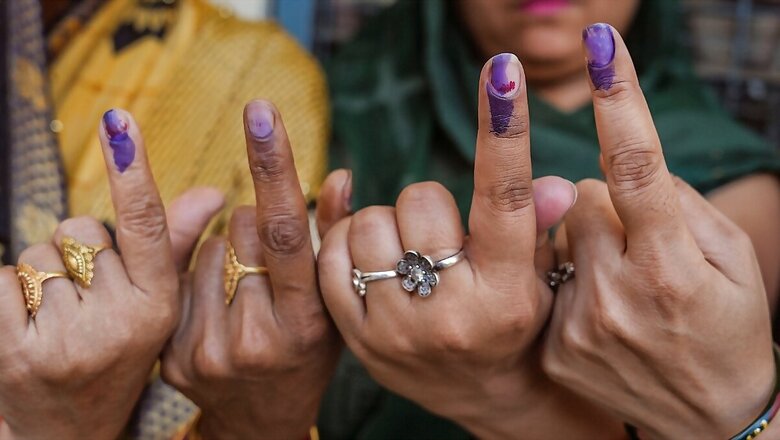
views
The East Delhi constituency is one of the seven Lok Sabha seats in the National Capital Territory of Delhi and is designated as a general category seat. It includes the entire East Delhi district, parts of Shahdara district, and parts of the South East Delhi district. The constituency is divided into ten assembly segments: Jangpura and Okhla in South East Delhi, Trilokpuri (SC), Kondli (SC), Patparganj, Laxmi Nagar, Krishna Nagar, and Gandhi Nagar in East Delhi, and Vishwas Nagar and Shahdara in Shahdara.
The constituency, located east of the Yamuna River, encompasses areas such as Seelampur, Shahdara, Gandhi Nagar, and Preet Vihar. It is one of the larger and more densely populated constituencies in Delhi, covering diverse neighbourhoods comprising people from different social and religious groups, with a voting population of over 16 lakhs and a total population of 25 lakh people.
Gautam Gambhir of the Bharatiya Janata Party has been the MP here since 2019, preceded by party colleague Maheish Girri who won in 2014, and Congress’s Sandeep Dikshit in 2009.
The key contenders here for the polls to be held on May 25 in the sixth phase of the ongoing general elections are Harsh Malhotra of the BJP and Aam Aadmi Party’s Kuldeep Kumar.
Political dynamics
BJP in Pole Position: While this seat has a history of swinging between the Bharatiya Janata Party and the Congress, the BJP remains in pole position this time as it seeks a hattrick in East Delhi. The Congress-AAP alliance under the INDIA bloc will amount to a boost for the opposition in terms of numbers, but it remains to be seen if the united opposition can ultimately surpass the BJP’s vote share which so far appears unlikely.
The BJP has been holding this seat for the last decade, with ace cricketer Gautam Gambhir representing it since 2019. Gambhir won the election with a massive margin of over 3.9 lakh votes, registering a vote share of 55% against Arvinder Singh Lovely who was contesting on a Congress ticket. This time, Gambhir, who was facing a sense of anti-incumbency against him, will not be contesting the polls. On March 2, he wrote to the BJP leadership seeking to be relieved from his political duties.
To replace Gambhir, the BJP has fielded party leader Harsh Malhotra, who is a former mayor of the erstwhile East Delhi Municipal Corporation. Of late, Malhotra has risen in the ranks of the party hierarchy, and with his selection, the BJP appears to be in the mood to reward dedicated and loyal ‘karyakartas’, while also addressing ant-incumbency with a fresh face and leveraging Malhotra’s reach among Punjabi voters.
In an organisational reshuffle, Malhotra, Yogesh Chandolia (candidate from Northwest Delhi), and Kamaljeet Sehrawat (candidate from West Delhi), were appointed party general secretaries to set in stone a general shift in Delhi BJP.
Malhotra is a die-hard organisational man, with tremendous sway among party workers, and solid connections with the party leadership. As per sources, he is good with numbers and electoral analysis skills which significantly helped the party in polling booth management and local surveys.
While Malhotra comes with a clean slate, he is poised to serve as a conduit for the pro-Narendra Modi vote. In East Delhi, national issues dominate, and the Modi wave remains intact. Development remains at the forefront of the reasons why the Prime Minister is so popular in the constituency. Moreover, welfare schemes such as Awas Yojana have made a significant mark in poorer areas of East Delhi. Further, there is strong support for the party over national matters like the removal of Article 370 in Jammu and Kashmir, the government’s approach to national security, its foreign policy successes, CAA implementation, and even the construction of the Ayodhya Ram Mandir.
The inclusion of former Congress leader Arvinder Singh Lovely, who contested from East Delhi against Gambhir in 2019 and enjoys a favourable image among Punjabi voters, will further bolster the BJP’s electoral performance in the constituency.
In the 10 assembly segments in East Delhi, the BJP has three MLAs— Abhay Verma from Laxmi Nagar, Om Prakash Sharma from Vishwas Nagar, and Anil Kumar Bajpai from Gandhi Nagar. While these MLAs are part of the campaign this election and are expected to ensure further support from their constituencies, the BJP will also be banking on the anti-incumbency faced by Aam Aadmi Party MLAs such as Praveen Kumar in Jangpura who faces dissatisfaction from the public. Anger against the local AAP government could be leveraged by the BJP, even as the general mood— ‘Kejriwal for Delhi, Modi for Desh’ — remains in East Delhi. Moreover, there is a section of voters that is unhappy with the AAP alliance with the Congress. With anti-Congress sentiments still prevalent in much of the electorate, the BJP hopes to make the most of it in its campaign rallies.
AAP’s Challenge: While in 2019, it was Atishi, currently the Education Minister in the Delhi government, who contested against the BJP’s Gautam Gambhir, this time, AAP has fielded Kuldeep Kumar, a 30-year-old leader from the Dalit community who has been making a name for himself within the ranks of the party as its Delhi unit vice president. He currently serves as the MLA from the Kondli constituency and was formerly the councillor from the Kalyanpuri ward. Having served as the Leader of the Opposition in the East Delhi Municipal Corporation, he is familiar with his opponent and remains a formidable pick against Malhotra.
Described as a loyalist of the AAP leadership, Kuldeep Kumar is known to be a close aide of ex-deputy chief minister Manish Sisodia who has been in jail for over a year under money-laundering and corruption cases related to an alleged liquor policy scam. When Sisodia was first arrested by the CBI, Kumar was one of the leaders protesting against the move.
In alliance with its former nemesis, the Congress, AAP hopes to consolidate a formidable vote share and give a tough fight to the dominant BJP. In 2019, AAP’s Atishi scored 17.5% of the vote share while the Congress’s Lovely got 24.4% against the BJP’s massive 55.5%.
Among many supporters of AAP, the anti-Congress sentiments still remain, which can prove to be a challenge for the bloc. Moreover, despite seven MLAs in the Lok Sabha constituency, the party faces anti-incumbency in some areas, which may further affect AAP’s performance. Already on the back foot in Lok Sabha elections, despite its dominance in assembly polls as seen in 2014 and 2019, AAP has an uphill task at hand when it comes to matching up to the BJP’s mammoth vote share.
Voter demographics
- Total voters (2019): ~16 lakh
- Urban: 100%
- Rural: 0%
- Literacy: 77.09%
- SC: 15.43%
- ST: 0%
- Hindu: ~77%
- Muslim: 18.9%
- Sikh: 2.92%
Key issues
Last-mile Connectivity: Metro connectivity has reached almost all parts of Delhi and people have enjoyed the comfort and affordability of the infrastructure. However, in the East Delhi Lok Sabha constituency, especially areas like Karkardooma, parts of Shahdara, Sarita Vihar, Jasola, and even Mayur Vihar, people are troubled by the absence of last-mile connectivity, particularly at night. People have demanded last-mile connectivity options in the region and, according to ground reports, see this as a major issue and want it addressed by the party they vote in power.
Ghazipur Landfill: Ghazipur landfill has become one of the major contentious issues in the region. The landfill is notorious for its immense size which can be seen from kilometres away along with the stench that has incensed the residents in Ghazipur, Mayur Vihar Phase 2 and 3, Gharoli, and Kondli. More than 2,000 tonnes of waste are dumped daily in the landfill while the waste processing is yet to pick up pace. Garbage in the landfill is burnt regularly, and the smoke blankets the region, causing breathing problems to the locals.
Delhi Riots: The Delhi riots of 2020 will be a major issue in the upcoming Lok Sabha elections in the East Delhi constituency, especially in the areas of Shaheen Bagh and Jamia. According to ground reports, voters are completely divided along communal and religious lines. The Hindus are in open support of the BJP and there is no counter-voting. Muslims on the other hand have refused to speak their mind but are determined not to vote for the BJP in these regions.
Safety and Security: Safety and security are major issues in the East Delhi constituency. Reasons attributed are income inequality in some areas, lower availability of civic amenities such as proper street lighting, etc.
Sewage: Proper sewage infrastructure is a major issue in parts of the East Delhi constituency. People are often stuck in their homes during the monsoon as water-logging paralyses movement. It also causes major road mishaps as dug-up roads due to constant issues with pipelines and sewage. These accidents have led to major injuries and even deaths.
Wazirabad Canal: The pollution of Yamuna in the Wazirabad canal after crossing Haryana is a major concern for the people. According to ground reports, the water remains clean in Haryana but as it flows into Delhi, the water turns muddy, contaminated, and has a pungent smell and taste to it which makes it unusable for drinking and other needs.
Water and Air Pollution: Pollution is a major concern for the residents of East Delhi. The pollution of the Yamuna and the government’s failure to clean it has been a major disappointment for the people. The area has a considerable Poorvanchali population, which celebrates the puja of Chhatt, making the issue of river pollution an issue of faith and religion. Air pollution on the other hand is a pan-Delhi issue. It is exacerbated when the officials burn down the garbage dumped at the Ghazipur landfill. The region also sees heavy smog and smoke during the winter months, especially after Diwali.
Civic Amenities: There is a considerable lack of civic amenities which has upset the people considerably in the region. Areas such as Shahdara suffer due to a lack of primary educational infrastructure, healthcare, and parking woes. The issue of a lack of hospital infrastructure has been raised in pockets of Shahdara along with better parking and educational facilities. The BJP candidate, in his manifesto, has vowed to solve these issues by setting up a Delhi University campus, and a multilevel car park.
Infrastructure development
Signature Bridge: It spans the Yamuna River at the Shourya section, connecting Wazirabad to East Delhi. It is India’s first asymmetrical cable-stayed bridge. The bridge was developed by the Delhi Tourism and Transport Development Corporation at a cost of over Rs 1,518 crore.
EWS Housing Component: It is a transit-oriented development (ToD) project comprising 498 flats on 23 floors in East Delhi’s Karkardomma area. It was completed in February this year at a cost of Rs 1,168 crore.
Delhi-Meerut RRTS: It is an under-construction semi-high-speed rail corridor that stretches across a distance of 82.15 km. The total estimated cost for the project is Rs 30,274 crore and will include 24 stations between Delhi and Meerut.
Jhuggi Clusters: The Delhi Development Authority will develop three jhuggi clusters in East Delhi in a bid to better the living conditions of people here. These JJ Clusters include Kalandar Colony, Deepak Colony, and Dilshad Vihar Colony which house nearly 4,000 households. This will be the first in-situ rehabilitation project in the entire trans-Yamuna area. The decision came after Delhi lieutenant governor VK Saxena visited the migrant-dominated areas of East Delhi, and was appalled to see the living conditions of people there. The clusters will be developed over about seven hectares of land, with multi-storeyed buildings having flats with modern amenities.
Explore in-depth coverage of Lok Sabha Election 2024 Schedule, Voter Turnout, Upcoming Phase And Much More At News18 Website


















Comments
0 comment